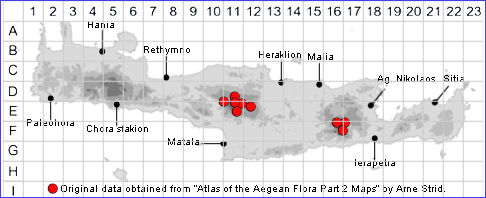
SCORZONERA MOLLIS subsp. IDAEA
Family:- COMPOSITAE/Sect. SCORZONERA
Common Names:- None
Synonyms:- Scorzonera idaea
Meaning:-Scorzonera (It) Derivation uncertain but generally thought to refer to use
as an antifebrile in snakebite.
Mollis (L) Softly hairy, soft.
Idaea (L) After Mount Ida in Crete, or Mount Ida in NW. Turkey.
General description:- Perennial. More or less arachnoid-tomentose or lanate
rootstock vertical, thick, stout, tuberous-incrassate and obovoid to oblong-
cylindrical.
Stems:-
1) Not more than 4 cm, several, simple, erect or ascending.
Leaves:-
1) 3-6 cm. All basal. Narrow, parallel-sided, acute, entire, sometimes with undulate
margins, dilated semi-amplexicaul at the base, usually crowded in the lower or
middle part of stem.
Flowers:-
1) Capitula with involucre 10-15 mm, up to 22 mm in fruit.
2) Ligules (¾-)1¼-1½ times as long as the involucre, lemon yellow above, reddish
beneath.
Fruit:-
1) Achenes 13-20(-28) mm, cylindrical, glabrous,
a) outer, squamulose
b) inner with smooth, weak ribs, pale brown, with a pale tubular base 1/10-1/5 as
long as the rest of the achene.
2) Pappus-hairs 1-1¼ as long as achene, plumose, dirty white.
Key features:-
1) Ligules yellow inside, yellow, reddish or purplish outside.
2) Achenes with a pale tubular base 1/10-1/3 as long as the rest of the achene.
3) Outer achenes 13-28 mm, with squamulose ribs.
4) Leaves 3-6 cm, all basal; entire, sometimes undulate at the margin.
5) Stems not more than 4 cm.
6) Involucre 18-27 mm.
7) Pappus-hairs dirty white.
8) Plant ± densely arachnoid-tomentose or -lanate throughout.
Habitat:- Dry stony meadows, open woodland, on various substrates. (0-)200-2300
m.
Distribution:- Cretan endemic. Known only from the Psiloritis and Dikti massifs.
Rare.
Flowering time:- Apr to early July.
Photos by:- Steve Lenton
Status:-
Conservation status (for threatened species): Rare (R) according to IUCN 1997.
Protection status (for threatened species): Greek Presidential Decree 67/1981.
SPECIES DESCRIPTION
